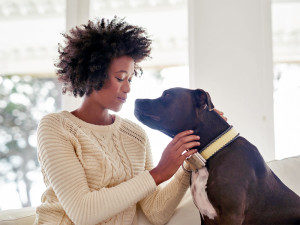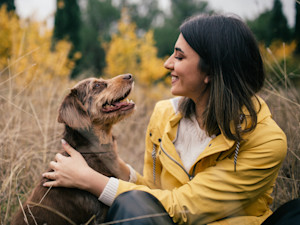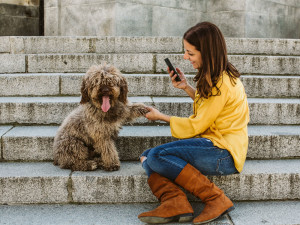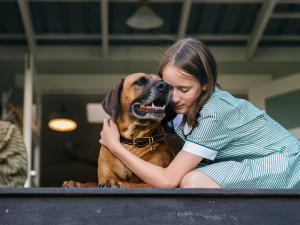10 Most Common Reasons Your Dog Is Staring at the Wall
Turns out they’re not daydreaming after all.

Share Article
In This Article:
Top Reasons Your Dog Is Staring at the Wallopens in a new tab What Should You Do if Your Dog Is Staring at the Wall?opens in a new tab When Is It Time to See a Vet for an Opinion?opens in a new tab
Imagine this: You’re watching your favorite show, a snack in one hand and your dog lounging nearby. Life’s good. Then you notice your pup staring at the wall. It’s not like there’s a stunning mural painted there, yet they seem locked in a trance. It can be creepy and a little concerning, but is your dog in deep thought or doing something else?
Dogs can’t verbally spill their inner monologue, so some body language and behavior may sometimes appear weird. That hypnotic stare could mean anything, from hearing sounds within the walls to a symptom of an undiagnosed medical condition.

littleKin™ is Kinship’s home just for puppy and kitten parents. Bop over to check out expert advice, new pet tools, and special deals—all curated for your newest family member.
opens in a new tabWhether curious or signaling something serious, there are a few reasons why your dog is staring at the wall instead of focusing on more enjoyable things around the room.
Main takeaways
Dogs may stare at walls out of curiosity, noticing subtle sounds, movements, or visual details that humans often miss.
Environmental changes, stress, or a clever bid for attention can trigger quirky behaviors like wall-staring.
Persistent wall-staring can indicate medical issues such as cognitive decline, vision problems, or neurological conditions.
Redirecting your dog’s focus with activities or toys can help, but compulsive or escalating behavior should be addressed.
Consult a vet if wall-staring becomes frequent, is accompanied by concerning symptoms, or marks a sudden behavior change.
Top reasons why your dog is staring at the wall
1. Curiosity
Dogs are naturally curious. They investigate everything — no clue too small, no smell too funky. So, it could be simple curiosity when dogs stare at the wall. Maybe a light flickered. Or there’s a weird shadow. Or a tiny spider skittered across the wallpaper. To your dog, staring at the wall is like watching a live nature documentary unfolding before their eyes.
2. Seeking attention
Dogs are clever. If they notice that staring at the wall will get your attention, they may do it to get words of concern, pets, and potential redirection of playtime or treats. If you respond to wall-staring with panic, worry, and belly rubs, your dog will use that tactic again.
3. Sensing movements or sounds
Dogs hear better, smell better, and see things we may not see (which is slightly terrifying to think about). When they stare at a wall, they might pick up faint noises like mice scurrying, pipes creaking, or the hum of electrical wires. To them, the sounds are fascinating. It may remind you to check for critters in the walls.
4. Compulsive behavior
Your dog is quirky, but staring at a wall could indicate compulsive behavior. Think of it as a dog’s version of zoning out, except it’s not always harmless. This kind of behavior could be linked to stress, boredom, or a mental health problem. If you feel like your dog stares at the wall excessively, it may be time to consult a behaviorist or veterinarian.
5. Something is on the wall
Before you call in a ghost-hunting team, look closer at the wall where your dog is staring. Is there a bug? A smudge? A light reflection dancing around from something outside? Dogs have better eyesight for motion than detail, so what looks like an ordinary wall to you may be a mural of moving shapes to dogs.
6. Cognitive dysfunction
Like humans, dogs’ brains can experience wear and tear as they age. Canine cognitive decline (CCD) is a condition like dementia that causes behaviors such as prolonged, excessive wall-staring. According to Dr. Alisha Kidwellopens in a new tab, a licensed veterinarian from the Cabarrus Animal Hospital in North Carolina, staring at walls can indicate cognitive decline in senior dogs. Other signs include confusion, agitated pacing, or forgetting basic commands they have known and practiced for years.
7. Seizures or neurological issues
If your dog stares blankly at the wall as if paused mid-thought, this could indicate a neurological disorder or a focal seizure. These “zoned out” moments may seem harmless but could signal an underlying health condition. Pay attention to your dog’s behavior and body language for other symptoms like twitching, loss of balance, or unresponsiveness.
8. Anxiety or stress
Dogs, like humans, have ways of dealing with stress. While you may binge chocolate, your dog may zone out and stare at the wall. Changes in environment — a move, new baby, or extended time away from you — can throw dogs into anxiety spirals. Staring at the wall may be a way for your pup to self-soothe or decompress when they feel anxious.
9. Vision problems
Have you ever noticed how you squint when something is blurry and hard to see? Your dog may be doing the same thing at the wall. Vision problems can make ordinary objects look shadowy or distorted, explaining a dog’s hyper-focus on something you can’t see. A quick check-up with a veterinarian can rule out eye problems.
10. Other medical issues
Staring at the wall is sometimes the canine equivalent of saying something is wrong. It could indicate underlying health problems, like brain tumors, liver issues, or vestibular disease. Call your veterinarian immediately if the behavior is sudden, accompanied by lethargy, uncoordinated movements, or vomiting.
What should you do if your dog is staring at the wall?
Assess the situation. Dogs are curious, sensitive creatures, and staring at the wall doesn’t always indicate something wrong. Observe their behavior and body language. Are they staring occasionally, or is it a new obsession? Are they acting like their usual tail-wagging, giddy selves? These initial clues can help you figure out what’s going on.
Before jumping to conclusions, check the wall. Look for anything that may grab your attention, like a light reflection, a small shadow or shimmer, a spider or other minor bug, or a weird, noticeable texture. Sometimes, it’s nothing more than a curious dog investigating their surroundings.
Dogs are creatures of habit and routine, so minor environmental disruptions can lead to odd, self-soothing behaviors, like staring at walls. Did you move the furniture? Have you brought home a new pet? Did you start using a new gadget that makes a strange noise? When stressed or anxious, dogs may exhibit anxiety by wall-staring or other quirky body language.
If the staring feels excessive, habitual, or compulsive, try to redirect your dog’s attention. Engage them in an activity they love, like playing fetch, solving a puzzle toy, or snuggling on the couch with you. If they are easily redirected, wall-staring may be a phase or a peculiar way for your dog to entertain themselves.
If this behavior persists, becomes more frequent, or includes concerning signs like pacing, whining, or ignoring everything else, consult a veterinarian. Document when and how often it happens, noting patterns and additional symptoms.
When is it time to see a vet for an opinion?
While occasional wall-staring can be chalked up to curiosity or quirky dog behavior, there are times when it’s more than a phase. Persistent or unusual wall-staring can indicate underlying medical or neurological issues that need immediate professional attention.
If you consult a vet, share your observations, including when the behavior started, how often it happens, and whether there are any changes in your dog’s health or routine. The vet will run tests like bloodwork and imaging, and possibly refer you to a specialist for further evaluation.
Being cautious is always best regarding your dog’s health. While staring at a wall may be nothing to cause concern, it could be a subtle way for your dog to tell you something. Be observant and proactive to ensure your pup remains happy, healthy, and more interested in their toys than your home’s drywall.
References
Burke, Angela, et al. “Why Is My Dog Staring at the Wall?” American Kennel Club, Jan 2020, www.akc.org/expert-advice/health/why-dog-staring-at-wallopens in a new tab.
“Why Does My Dog Look at the Wall – [Vet Explains Pets].” Vetexplainspets.com, 2024, vetexplainspets.com/why-does-my-dog-look-at-the-wallopens in a new tab. Accessed 31 Dec. 2024.

Valerie Mellema
Valerie Mellema has a Bachelor of Science in Agribusiness and Equine Industry from West Texas A&M University. She has been a professional writer for the past 20 years, covering a wide variety of pet health and care topics before founding a nonprofit focused on mental health in children and thoroughbred aftercare. She has four Border Collies and eight retired racehorses.
Related articles
![weird dog rolling in poop]() opens in a new tab
opens in a new tab7 Weird Dog Behaviors Explained
Chasing their tails, eating grass, and rolling in garbage — should you worry?
![happy woman with a dog]() opens in a new tab
opens in a new tabHow to Keep Your Dog’s Brain Healthy for as Long as Possible
What happens to a dog’s brain when they get older—and how you can slow it down.
- opens in a new tab
Can Dogs See Ghosts? What Science Says
This isn’t The Sixth Sense, but dogs are powerfully perceptive.
![Woman training a brown dog to take a photo]() opens in a new tab
opens in a new tabHow to Train Your Dog to Pose for Photos
For better dog photos, focus on your pup’s natural behaviors.
![Young girl hugging an older dog on porch]() opens in a new tab
opens in a new tabHow to Recognize and Treat Canine Dementia
Learn about the signs, symptoms, and treatments.
![A dog looking up with a cute face]() opens in a new tab
opens in a new tabHow to Get Your Scared Dog to Trust You
Using these tips, your skittish dog will warm up to you.







